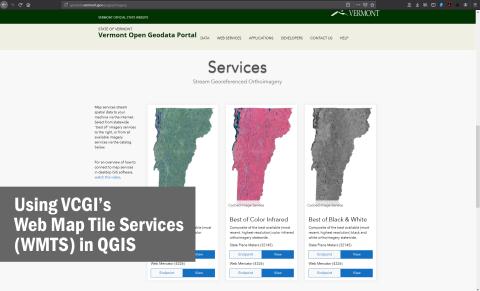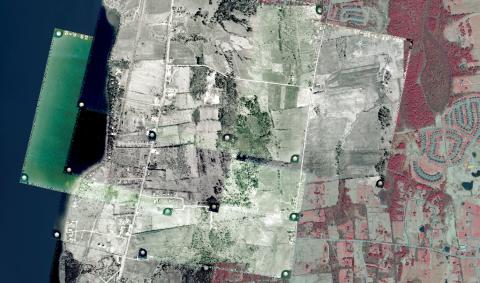Resources
VT Open Geodata Portal: ArcGIS Server Web Services Configuration Guidelines
This guideline outlines best practices for creating ArcGIS Server web services and registering them with AGO for the purpose of supporting the federating VT Open Geodata Portal.
ArcSDE Configuration and Management Guidelines
This guideline is designed to help agencies in the State of Vermont who plan
to configure and manage an ArcSDE1 installation. It includes a set of guidelines that
will help ensure greater compatibility between Agencies in the State of Vermont. The
hope is that this will lead to improved data sharing and exchange, and create the
foundation for an Enterprise VGIS System.
to configure and manage an ArcSDE1 installation. It includes a set of guidelines that
will help ensure greater compatibility between Agencies in the State of Vermont. The
hope is that this will lead to improved data sharing and exchange, and create the
foundation for an Enterprise VGIS System.
Vermont GPS Guidelines
This section can be used as a stand-alone reference to aid users of Global Positioning Technology (GPS) in gaining a better
understanding of the technology and to improve the quality and accuracy of the data they acquire. It also provides the
foundation for Section B - Data Accuracy Standards and Section C - Content Specifications that are geared to support
project where GPS data is acquired through contractual agreements.
understanding of the technology and to improve the quality and accuracy of the data they acquire. It also provides the
foundation for Section B - Data Accuracy Standards and Section C - Content Specifications that are geared to support
project where GPS data is acquired through contractual agreements.
Horizontal Datum Conversions
This paper outlines the steps required to convert ARC/INFO coverages
from the North American Datum of 1927 (NAD27) to the more
accurate North American Datum of 1983 (NAD83).
from the North American Datum of 1927 (NAD27) to the more
accurate North American Datum of 1983 (NAD83).
Managing Data Layer Updates
Data maintenance is often an expensive yet neglected aspect of
managing GIS data. Each data layer is unique and will have its own
system for making and tracking updates. By consequence, tools for
data maintenance are generally not built into GIS software.
This guideline contains a collection of techniques and procedures for
managing GIS data layer updates. Appropriate techniques can be
adopted (with modification as need be) for a given data layer. Some
data layers change very little over time, and may only require simple
procedures for reporting errors and making rare revisions. Other layers
change often and require procedures for recording updates in a manner
that supports quality control and tracking of changes over time. A full
range of techniques is discussed here, including methods which enable
an audit trail of modifications over time for a given feature. The text is
primarily intended for those familiar with the Arc/Info GIS software.
managing GIS data. Each data layer is unique and will have its own
system for making and tracking updates. By consequence, tools for
data maintenance are generally not built into GIS software.
This guideline contains a collection of techniques and procedures for
managing GIS data layer updates. Appropriate techniques can be
adopted (with modification as need be) for a given data layer. Some
data layers change very little over time, and may only require simple
procedures for reporting errors and making rare revisions. Other layers
change often and require procedures for recording updates in a manner
that supports quality control and tracking of changes over time. A full
range of techniques is discussed here, including methods which enable
an audit trail of modifications over time for a given feature. The text is
primarily intended for those familiar with the Arc/Info GIS software.
Contracting with GIS Consultants
This guideline provides local communities with guidance in
developing a project and project goals, preparing a request for
proposals (RFP), and executing a contract for GIS mapping or
analytical services. Included are technical and administrative
specifications that are important to ensure the creation of a quality
community product useful for many years to come.
developing a project and project goals, preparing a request for
proposals (RFP), and executing a contract for GIS mapping or
analytical services. Included are technical and administrative
specifications that are important to ensure the creation of a quality
community product useful for many years to come.
GIS Data Directories and File Names
This document is primarily for ARC/Info system managers and
technicians. The directory and file naming conventions recommended here are used
by VCGI. Communications with VGIS sites and user support will be
simplified if these conventions are followed. Also, any applications,
software or SMLs/AMLs developed by VCGI will use these
conventions. Most importantly, if these conventions are followed, this
document can serve as part of your system documentation for future
users at your site.
technicians. The directory and file naming conventions recommended here are used
by VCGI. Communications with VGIS sites and user support will be
simplified if these conventions are followed. Also, any applications,
software or SMLs/AMLs developed by VCGI will use these
conventions. Most importantly, if these conventions are followed, this
document can serve as part of your system documentation for future
users at your site.


